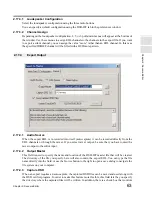
54
Chapter 2: Sonoma Editor
C
hap
te
r 2:
So
no
m
a
Edi
tor
of illegal authoring marks so they appear as type
CD*
rather than
CD
in the mark list and the mark
changes color in the EDL. Illegal Start marks are still auto-numbered. Illegal Index and End marks
are not given serialized names (they are simply named End, Index).
Here is a summary of illegal authoring marks:
- Authoring marks closer than the minimum times identified in §
2.15.2.2
.
- Any End or Index mark preceding the first Start mark
- An End or Index mark immediately following a legal End mark
- An End or Index mark immediately following an illegal mark
A mastering file cannot be created if there are illegal Start marks. The application will ignore illegal
Index and End marks when it creates a mastering file.
2.15.2.4
Mark Offsets
Start and Index marks can have an offset of 0, 1, 2, 3, or 4 frames (at 75 fps). The offset of each mark
can be changed in the mark editor (see below). When a Start or Index mark is created it is assigned
the default offset which is specified in the editing preferences page. The recommended default offset
is 4 frames. An authoring mark’s position in the EDL will not reflect its offset. The offset value is
used when auditioning the mark (see §
2.15.6
) and when exporting the EDL to an SACD mastering
file (see §
2.17
).
2.15.2.5
Track Muting Flags
The SACD mastering system gives the user the ability to set channel mute flags on a track-by-track
basis. There are four track muting flags named TMF1, TMF2, TMF3, TMF4; they indicate muting of
the front, rear, center, and LFE channels respectively. The flags are stored in each track’s Start mark.
When a new Start mark is created, all its mute flags are initially off. To toggle a track mute flag,
Alt-click
on the Start mark in the mark list (see §
2.15.5.4
). The effect of setting track mute flags
depends on the implementation in the SACD player.
Ingredient marks represent positions in an ingredient. Ingredient marks are created using the add
ingredient mark command. The effect of this command depends on the state of the transport. When
the transport is idle, ingredient marks are created inside all selected ingredients that intersect the
Nowline. When the transport is running, ingredient marks are created only inside the new ingredients
that are being created on channels that are recording.
Only one ingredient mark of each type can appear at any given position in an ingredient. Adding an
ingredient mark at a position where a mark of the same type already exists has no effect.
When an ingredient moves, the ingredient mark moves along with it. When an ingredient is copied,
all of its ingredient marks are also copied.
When an ingredient is trimmed, some of its ingredient marks may be out of the playable range. In this
case the marks are not drawn. If the ingredient bounds change so that ingredient marks are in the
playable range, they will reappear.
If Sonoma detects an error while playing or recording it will create an error mark. The text of the
error mark describes the problem. (You cannot edit the info. field of an error mark.) Error marks are
identified as type
ERR
in the mark control panel’s mark list. Playback errors appear in the EDL
timeline. Recording errors appear inside ingredients. Recording error marks behave like ingredient
2.15.3
Ingredient Marks
2.15.4
Error Marks
Содержание SONOMA
Страница 12: ...Sonoma Audio Workstation User Guide Copyright 2003 Sony Corporation of America All rights reserved ...
Страница 18: ...Sonoma Audio Workstation User Guide xvi ...
Страница 22: ...4 Chapter 1 Introduction Chapter 1 Introduction ...
Страница 90: ...72 Chapter 2 Sonoma Editor Chapter 2 Sonoma Editor ...
Страница 120: ...102 Chapter 3 Sonoma Mixer Chapter 3 Sonoma Mixer ...
















































